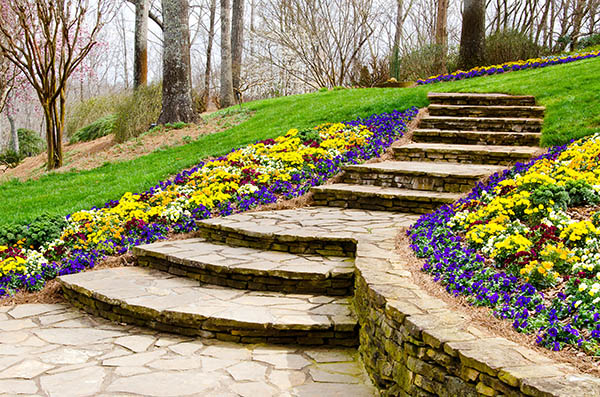Upgrade your outdoor space with Steep hill landscaping techniques.
Upgrade your outdoor space with Steep hill landscaping techniques.
Blog Article
Achieve a Beautiful Outside Oasis With Thoughtful Steep Hill Landscaping Solutions
Changing a high hillside into an exciting outdoor sanctuary provides one-of-a-kind challenges that need cutting-edge landscape design options. Techniques such as terracing, the installation of keeping wall surfaces, and the choice of indigenous plants play crucial roles in this process. Furthermore, integrating water features can better enhance the landscape's allure.
Understanding Steep Hill Obstacles
Landscaping on high hillsides presents unique challenges that need careful factor to consider and critical preparation. The disposition of the surface can result in concerns such as soil erosion, water drainage, and limited accessibility, every one of which need to be addressed to create a practical and aesthetically pleasing outside area.
Among the key issues with high hill landscape design is erosion, which can arise from hefty rains or inappropriate water drainage. This not just affects plant health however can likewise endanger the security of the slope. Executing effective erosion control actions, such as growing deep-rooted greenery or using compost, is crucial in protecting the stability of the landscape.

Designing With Terracing Methods
To reduce the obstacles presented by steep hills, including terracing strategies can be an effective service. This layout approach transforms a sloped landscape into a series of flat, level locations, creating an aesthetically striking and functional outdoor space. Terracing not only helps to avoid soil erosion yet also assists in far better water drainage, which is critical in maintaining the wellness of plants and the security of the hillside.
When developing terraces, careful consideration of the slope's angle and the soil type is crucial. Each terrace ought to be tactically placed to make the most of sunlight exposure while minimizing the danger of runoff. The use of native plants on each level can boost biodiversity, advertise sustainability, and minimize upkeep demands. Additionally, incorporating paths in between terraces can improve accessibility and urge exploration of the landscape.
Terraced yards can offer multiple purposes, including veggie manufacturing, ornamental display screens, or outdoor seating locations. By utilizing materials that blend sympathetically with the surrounding setting, the terracing can boost the general aesthetic allure of the building. Ultimately, thoughtful terracing transforms high hillsides into useful, gorgeous spaces that invite interaction and satisfaction.
Applying Preserving Wall Surfaces
When confronted with the challenges of high terrain, applying retaining walls can offer both architectural support and aesthetic improvement to a landscape. These wall surfaces offer to avoid soil disintegration, maintain slopes, and develop flat areas for horticulture or entertainment use. Steep hill landscaping. By effectively taking care of water overflow and reducing soil motion, keeping wall surfaces secure your landscape financial investment while boosting safety and security

Specialist installment is crucial to ensure the durability and efficiency of preserving wall surfaces. Appropriate drainage systems have to be included to soothe hydrostatic pressure, avoiding structural failing. Consulting with landscape professionals will certainly make certain that the style straightens with your overall vision while sticking to regional guidelines.
Deciding On Indigenous Plants
Selecting indigenous plants for your landscape design uses countless environmental and visual benefits. Steep hill landscaping. Indigenous plants are adapted to the neighborhood climate and dirt conditions, needing much less water and upkeep contrasted to non-native species. This adaptability not only conserves resources however additionally promotes a much healthier environment, as native plants support regional wildlife, consisting of pollinators such as bees and butterflies
Integrating indigenous plants into your high hillside landscape design can boost soil stability, decreasing erosion and promoting a balanced community. Ingrained native plants aid secure site the soil, making them suitable for sloped areas. In addition, these plants frequently exhibit lively colors and diverse textures, creating a visually attractive landscape that integrates with the surrounding environment.
When choosing indigenous plants, consider review their development behaviors, seasonal interest, and compatibility with various other species. Organizing plants with similar water and sunlight needs can cause a much more natural style, while additionally simplifying upkeep. By choosing indigenous plants, you not just grow a lasting outside oasis yet likewise add positively to the local biodiversity, guaranteeing that your landscape grows for several years ahead.
Incorporating Water Functions
Incorporating water attributes into your high hillside landscape design can substantially boost both the visual appeal and environmental performance of the room. The sound of streaming water creates a tranquil atmosphere, while visually, it can offer as a centerpiece that attracts the eye and adds deepness to the landscape.
When choosing water functions, take into consideration alternatives that complement the natural shapes of your hillside. Waterfalls, for circumstances, can cascade down the slope, creating visual passion check it out and advertising healthy and balanced drain. Fish ponds can additionally be integrated into the layout, encouraging local wild animals and providing environments for numerous varieties.
In addition, the positioning of plants around these attributes is critical. Indigenous aquatic plants not just boost the elegance of the water feature but also add to its environmental equilibrium by filtering system pollutants and offering food for neighborhood animals.
Maintenance is one more crucial aspect; guarantee that your water feature is developed for simple upkeep. An effectively constructed attribute will certainly require minimal treatment, enabling you to delight in the appeal and tranquility it provides without too much labor. Ultimately, attentively incorporated water functions can change your steep hill landscape into a captivating outside sanctuary.
Verdict
In final thought, transforming a high hill right into an attractive outdoor oasis necessitates thoughtful landscaping approaches that resolve disintegration control and ease of access. The assimilation of terracing methods, the implementation of preserving wall surfaces, and the choice of native plants are necessary components of effective design.
Report this page